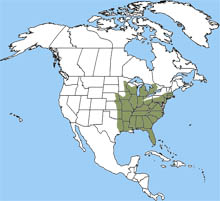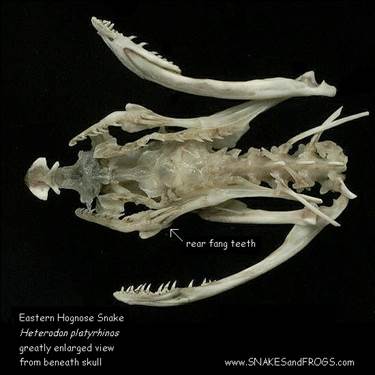These snakes are often called puff adders and are thick bodied, non-venomous snakes found in the eastern United States. Hognose snake range from southern Florida and east to Texas, north to central New England, the Great Lakes Region, and into southern Canada. They have quite a list of alternative names such as chunk head, hissing snake, and rock adder, among others. They typically prefer woodlands with sandy soil, field edges, and costal scrub and forests. It is easily distinguished by its upturned nose, which is used for digging in sandy soils.

hey are a quite handsome snake and display a wide array of color patterns with a background that can be yellow gray, brown, greenish, or black and patterned with large rectangular spots along the middle of the back. The scales are keeled (raised ridge as opposed to smooth) and the underside of the tail is usually lighter. You can tell the females as they have a fine taper to the end of the tail contrasting with the males, which have a slight bulge near the cloaca followed by a more drastic taper of the tail.
Hognose snakes are active only in the daytime and can often be encountered as they cross roads or trails in the spring and fall. They prey upon frogs, salamanders, small mammals, birds, and invertebrates but by far their favorite prey is toads. In many areas toads are their exclusive prey. They appear to be immune to the toxin that toads produce and they are equipped with large, rear fangs in the back of their mouth that are used to puncture toads when they inflate as a defensive mechanism (one flattened toad – coming up! – or down). Heterodon – different tooth – referring to the rear fangs, and platyrhinos – flat nosed.

They become sexually mature around two years old. Hognose snakes are oviparous – they breed in the spring and deposit 15-25 eggs in a depression in sandy soil or under logs or rocks. The eggs will hatch, unattended, in 1 to 2 months. The will begin hibernation in October or early November – depending where in the range they live. Their home range is about an acre, which they traverse in search of food and mates.
If you don’t know the species they can be quite intimidating when approached. They will suck in air, spread the skin around its head and neck (like a cobra), let out a loud hiss, and strike towards the threat. But oddly – they will never bite! If that doesn’t work then they will turn over on their back and writhe around on the ground with mouth open and tongue hanging out as if they are having some sort of seizure, emit a foul musk from their cloaca – and then play dead. A ploy worthy of an Oscar.
There is a problem though. The snake has a strong idea of what “dead” should be – so if you pick it up and turn in over right-side-up, it will immediately flip back to the “dead” position. There are limited reports of getting bit by a hognose snake -one was a researcher in a lab setting who had first been handling toads and then with to pick up a hognose – so maybe it got a good sent of toad and then struck. Others have experienced mild swelling and pain attributed to a mild toxin in the saliva.

Oh — and while at Boy Scout camp in the summer in N.J. I would spend way, way too much time searching for hognose snakes on the vaguest of rumors by some counselor that someone, at some time, saw one down near the bridge recently. Day after day, coming up empty handed only with a few ring-necks, water snakes, or rat snakes to show for my efforts. I would usually start each day behind camp after an early rise — flipping talus rocks for an hour or so in search of — well, some reptile or amphibian.
One morning with no prize found I decided it was time to head to breakfast and trotted down the dirt road to the mess hall. And how lucky could a kid get – there was a hognose parked in the middle of road basking in the early morning sun. As I approached him he did what was expected –curled up, flattened his head, rose up and let out a guttural hiss. I knew he was going to do this but was taken aback – enough to double-check my thoughts – this is a hognose, right?
I did go to pick him up – he continued with the act and stuck as if to bite and then went into that glorious fake death scene – no second to Laurence Olivier. I watched the scene unfold for a bit and then picked him up and set him down in the forest, leaving him upside down with his mouth draped open. And then off to breakfast. It was going to be a good day.
